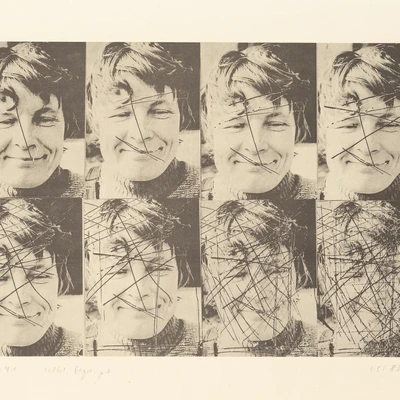Toni Florence Mau
- * 1917
- † 1981
Life dates
- Artist
Category
Wilfully experimental silkscreen pioneer with an eccentric sense of humor
Toni Florence Mau was without a doubt one of the GDR’s most wilfully experimental artists, even if her world of fantastic forms garnered little public attention in the context of the GDR. Born 1917 in Berlin-Reinickendorf, Mau studied in Charlottenburg between 1934 and 1946, taught after 1953 at the East German art academy in Berlin-Weissensee, and lived as a free-lance graphic artist and sculptor in Berlin-Schöneiche. The medium of the silkscreen was for Tonia Mau what the lithograph was for Arno Mohr: beginning in the 1950s, Mau was one of the first artists in the GDR to explore in depth the technique of the stencil. She established silkscreen courses in the workshops of the (East-) Berlin Künstlerverband (Artists’ Union) and also taught its basic techniques to students at the Kunsthochschule Berlin-Weissensee. Although Toni Mau was highly esteemed as a teacher and expressed a "politically correct" optimism in her compact-contoured images in the form of farmer portraits, mother and child scenes, and beach landscapes, she was dismissed from her teaching position after just four years on grounds of "suspected formalism". Nevertheless, she remained a member of the Verband Bildender Künstler and her works were often included in exhibitions in the GDR. The FDGB (Freier Deutscher Gewerkschaftsbund, an East German association with the mission of educating workers) frequently bought silkscreen images from Mau and she obtained commissions for art installed in public buildings in East Berlin. Her most prominent works, which can still be seen today, doubtless include the leaded stained windows in Berlin’s Rotes Rathaus (City Hall), her ceramic ornament Entwicklung der Raumfahrt (evolution of space exploration) on a pediment in Prenzlauer Berg, and the figurative sandstone relief in the entrance hall of the Kunsthochschule Berlin-Weissensee.
But most intriguing by far are the freely expressive graphic works full of dream landscapes and fabulous creatures, which recall medieval mystery plays. Her most prolific year was 1964. Two years later, she acquired a copperplate printing press and was able to start producing relief prints and prints on rough-surface media. Her recurring motifs include Nature (the nature of woman), fairy-tale worlds and futurist dreams, fantasies and emotions, which she depicts in a unique style exhibiting a fascinating tension between figurative and abstract-surreal aesthetics. Mau’s humor and poetic fantasy are evident in titles for her works such as Sangesfreudige Zwitterwesen (Song-Happy Hermaphrodite), Mikroleben (Microlives) or Gehuppt wie gesprungen (By Hook or by Crook). "The artist’s sensibility," wrote an art historian in 1974 on the occasion of a Mau exhibition in Berlin’s Galerie im Turm, "records the tensions in our era heavy with conflicts and the impact those tensions have on our emotional life and modes of behavior. The anthropomorphic animal and plant forms, which come to life on Mau’s idiosyncratic graphic works and miniatures, are visually realized metaphors of these problems."[1] The woman who, along with artists such as Arno Mohr, Herbert Sandberg, or Theo Balden shaped in her very individual way the post-war art of Berlin, died seven years later. Today, Toni Mau’s engagement with the form of the silkscreen and the printing press in the GDR has yet to be adequately studied and appreciated. She, too, is one of the "lost women"[2] of East German art history—one whose oeuvre, full of surprises, is being discovered a full thirty years after the fall of the Wall by institutions such as the Schloss Biesdorf in Berlin.
text: Sylvie Kürsten, translation: Darrell Wilkins
[1] Ewa Garztecka in a flyer for the exhibition "Toni Mau" at the Galerie im Turm, Berlin, 1974
[2] This term is based on the film and online project "Lost Women Art - A forgotten piece of art history" from 2021, https://www.lostwomenart.de.
Works by Toni Florence Mau
Travelling exhibition
Publik machen: 40 Künstler:innen aus dem Bestand des Zentrums für Kunstausstellungen der DDR
Popular keywords
Many more works are hidden behind these terms
